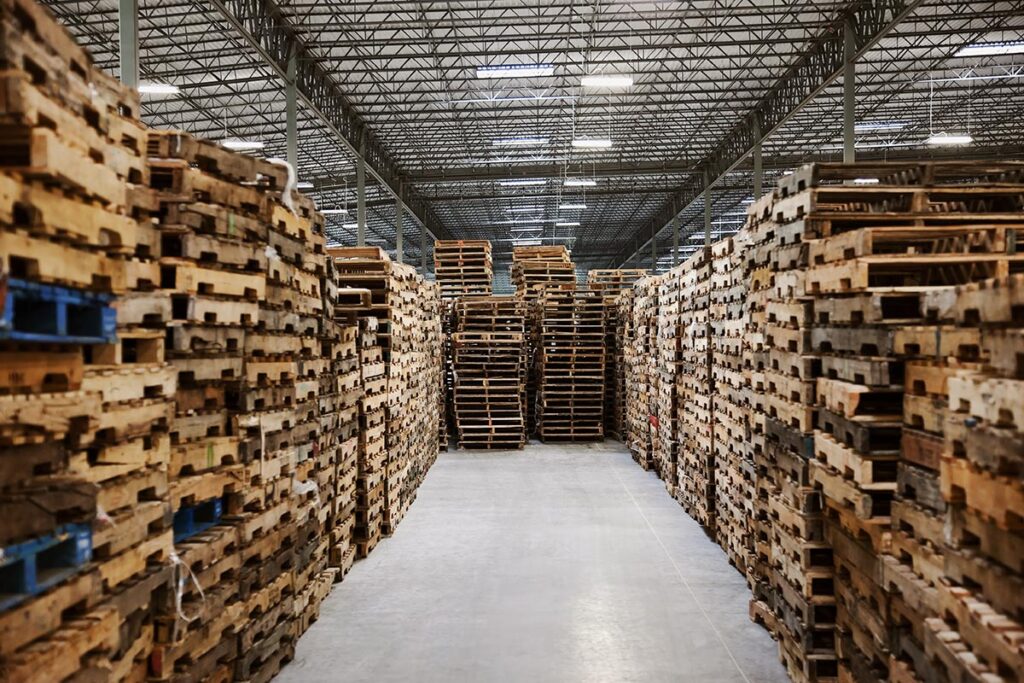Old pallets, especially wooden ones, hold significant value beyond being waste. Their worth depends on material, condition, size, market demand, regulatory compliance, and potential uses.
Global Market Overview
The global pallet market was valued at USD 76.7 billion in 2025 and is expected to reach USD 122.08 billion by 2034 (5.3% CAGR). North America generated USD 24.04 billion in 2025, while Asia Pacific accounts for about a third of global revenue. As RePackify reports the wooden pallet market has seen a 10% price drop for used versions in the last year, with prices starting at $2.50 and averaging $6 nationally.
Factors Affecting Pallet Value
Material Type
Wooden Pallets:
- Most common, typically 48″×40″ in North America
- Used pallets sell for USD 4–10 each
- Grade A pallets: USD 5–8 in bulk
Plastic Pallets:
- More durable, moisture-resistant
- Used: USD 10–40
- New: USD 40–80 each
Metal Pallets:
- Steel/aluminum: USD 50–200+
- Pricing depends on scrap metal rates
Condition and Grade
Grade A (Like-New): USD 5–8 each for standard wood pallets Grade B (Repaired): USD 3–6 each with minor repairs Damaged Cores: Often free pickup, limited salvage value
Size and Geographic Demand
Standard 48×40″ GMA pallets have highest demand in U.S. logistics. Regional variations exist: Phoenix Grade A wood pallets average USD 5.05, while Texas brokers pay USD 4–8 depending on load size and logistics.
ISPM 15 Compliance
International shipments require International Standards for Phytosanitary Measures No. 15 (ISPM 15) compliance. Wooden pallets need heat treatment or methyl bromide fumigation plus a compliance “wheat stamp.” Over 120 WTO members have adopted ISPM 15, including EU, USA, Canada, China, India, Japan, and Australia. Non-compliant pallets risk border rejection.
Monetization Strategies
Direct Sales to Brokers
Pallet brokers purchase loads of 250–700 pallets at USD 4–8 per reusable wood pallet. The National Wooden Pallet & Container Association (NWPCA) facilitates connections.
Scrap and Material Recovery
- Wood chips: USD 0.50–2 per pallet by weight (average pallet weighs 40–50 lb)
- Metal components: USD 0.10–0.50 per pound at scrap yards
Repair and Refurbishment
Professional repair includes sorting, inspecting, plugging stringers, reinforcing, replacing deck boards, and quality grading. This extends pallet life and ensures safety standards.
DIY Upcycling
Creative upcycling into furniture, planters, and décor yields USD 10–50+ per piece through platforms like Etsy and local craft markets.
Pallet Pooling Services
Pooling operators provide rental and circular use models, lowering total ownership costs and environmental impact while handling storage, repair, and repositioning.
Sustainability and Circular Economy
Wooden pallets achieve 95% recovery rates in the U.S., far exceeding other packaging materials. They demonstrate circularity through:
- Renewable materials
- Closed-loop pooling systems
- Repair and parts harvesting
- End-of-life energy recovery
Life-cycle assessments show wooden pallets generate 11.2–16.1 kg CO₂ eq. per trip versus ~57 kg CO₂ eq. for plastic pallets.
Emerging Innovations
NetZero Pallets: Made from coconut husks, capturing up to 116.7 kg of CO₂ per unit Smart Pallets: Feature RFID or IoT sensors for real-time tracking RF Treatments: Lower environmental impact while meeting ISPM 15 standards
Best Practices to Maximize Returns
Optimize Condition
- Maintain great shape through regular maintenance
- Remove debris frequently
- Make quick repairs for Grade A pricing
Leverage Bulk Sales
Combine into truckloads of 250+ units for best broker rates and reduced handling fees.
Ensure Compliance
Proper ISPM 15 treatment and stamping boosts resale opportunities for international markets.
Use Documentation
Standard marking and digital records improve traceability, reduce losses, and enable warranty models.
Key Takeaway: Old pallets represent valuable, eco-friendly assets. Understanding market dynamics, regulations, and circular economy principles enables individuals and businesses to convert used pallets into profitable resources while reducing environmental impact. Strategic sorting, grading, targeted sales channels, and innovative upcycling maximize returns and sustainability benefits.

